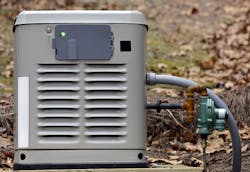The NEC requirements specific to generators are in Art. 445. A generator is essentially a motor that is configured to supply power when rotated, rather than rotate when power is supplied to it. Yet while Art. 430 is the longest article in the NEC, Art. 445 is among the shortest. That’s because the energy supply to a generator is kinetic rather than electrical.
Because a generator is essentially a motor, the location requirements for motors [Sec. 430.14] also apply to generators [Sec. 445.10]. Locate generators so that:
- They have adequate ventilation.
- Maintenance can be readily performed.
- If they have open commutators or collector rings, sparks can’t reach combustible material.
Additionally, a generator must be of a type suitable for the location. Consider, for example, what might get into the generator (e.g., combustible dust, diesel fumes, water, etc.). All of this is on top of the mechanical considerations — for example, siting the generator such that its pedestal is accessible to lifting equipment for installation and removal. This factor is why generator rooms have double doors rather than personnel doors.
Manufacturers must apply specific markings to the generator, and those are identified in Sec. 445.11. A smart move when the generator is bought “build to order” is to ask the manufacturer to send you photos of the nameplate before shipping the unit to your location. You can address any errors then, thus eliminating perhaps several days of delay. Have these checked again when receiving, so you don’t suddenly realize there’s a problem only after it’s been transported across the site and hoisted into place.
Overcurrent protection requirements [Sec. 445.12] depending on whether you have one of these five configurations:
- Constant voltage generator
- Two-wire generators
- 65V or less
- Balance sets
- Three-wire, direct-current generators.
What about the ampacity of the conductors from the generator output terminals to the first distribution device(s)? That ampacity must be at least 115% of the nameplate current rating of the generator [Sec. 445.13(A)]. This is another good reason to get a photo of the nameplate before the generator ships; you can know for sure the conductors you specified for this project are the correct size. Finding out they are wrong only when the generator is on site can mean project delays even with expediting fees paid out. The exception to Sec. 445.13(A) allows you to use 100% of the nameplate rating if the design and operation of the generator will prevent overload.
You can size the neutral per Sec. 220.61 (feeder or service neutral load). Any conductors that must carry ground fault currents cannot be smaller than required by Sec. 250.30(A). Any neutral conductors that must carry ground-fault currents cannot be smaller than the minimum required size of the largest conductor.
Generators other than cord-and-plug-connected portable generators must have at least one disconnecting means [Sec. 445.18]. It must simultaneously open all associated ungrounded conductors. There also must be a provision for emergency shutdown of the prime mover [Sec. 445.10]. For other than one- and two-family dwelling units, generators larger than 15kW must have a remote emergency stop switch to shut down the prime mover.
About the Author

Mark Lamendola
Mark is an expert in maintenance management, having racked up an impressive track record during his time working in the field. He also has extensive knowledge of, and practical expertise with, the National Electrical Code (NEC). Through his consulting business, he provides articles and training materials on electrical topics, specializing in making difficult subjects easy to understand and focusing on the practical aspects of electrical work.
Prior to starting his own business, Mark served as the Technical Editor on EC&M for six years, worked three years in nuclear maintenance, six years as a contract project engineer/project manager, three years as a systems engineer, and three years in plant maintenance management.
Mark earned an AAS degree from Rock Valley College, a BSEET from Columbia Pacific University, and an MBA from Lake Erie College. He’s also completed several related certifications over the years and even was formerly licensed as a Master Electrician. He is a Senior Member of the IEEE and past Chairman of the Kansas City Chapters of both the IEEE and the IEEE Computer Society. Mark also served as the program director for, a board member of, and webmaster of, the Midwest Chapter of the 7x24 Exchange. He has also held memberships with the following organizations: NETA, NFPA, International Association of Webmasters, and Institute of Certified Professional Managers.
